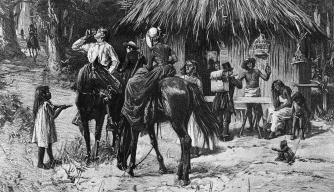Many thousands of years before Christopher Columbus’ ships landed in the Bahamas, a different group of people discovered America: the nomadic ancestors of modern Native Americans who hiked over a “land bridge” from Asia to what is now Alaska more than 12,000 years ago. In fact, by the time European adventurers arrived in the 15th century A.D., scholars estimate that more than 50 million people were already living in the Americas. Of these, some 10 million lived in the area that would become the United States. As time passed, these migrants and their descendants pushed south and east, adapting as they went. In order to keep track of these diverse groups, anthropologists and geographers have divided them into “culture areas,” or rough groupings of contiguous peoples who shared similar habitats and characteristics. Most scholars break North America—excluding present-day Mexico—into 10 separate culture areas: the Arctic, the Subarctic, the Northeast, the Southeast, the Plains, the Southwest, the Great Basin, California, the Northwest Coast and the Plateau.
THE ARCTIC
The Arctic culture area, a cold, flat, treeless region (actually a frozen desert) near the Arctic Circle in present-day Alaska, Canada and Greenland, was home to the Inuit and the Aleut. Both groups spoke, and continue to speak, dialects descended from what scholars call the Eskimo-Aleut language family. Because it is such an inhospitable landscape, the Arctic’s population was comparatively small and scattered. Some of its peoples, especially the Inuit in the northern part of the region, were nomads, following seals, polar bears and other game as they migrated across the tundra. In the southern part of the region, the Aleut were a bit more settled, living in small fishing villages along the shore.



